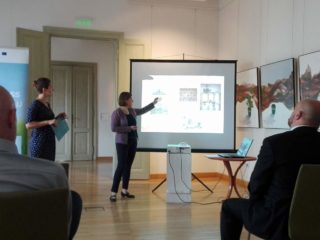Art Nouveau in Szeged
Restoration of Szeged, after the great flood in 1879, defined the character of today’s Szeged. The majority of old buildings were then demolished and new buildings and palaces took their place. Regarding that event, in one of the stained glass windows in the Szeged City Hall a promise of Emperor Francis Joseph is preserved: “Szeged will be much more beautiful than it was before.” And so it was. At the beginning of the twentieth century, new Art Nouveau buildings nestled themselves within the already established urban core.
In both Szeged, and Subotica, we can recognize two directions in Art Nouveau architecture. One direction, represented by avant-garde Hungarian artists, following their European counterparts, believed that industrial development leads to the destruction of beauty and that art should be introduced into everyday life, relying on vernacular architecture and tradition by using local materials. In search of national characteristics, studying folklore, folk art and vernacular architecture – a form of Art Nouveau with national characteristics was created – the Hungarian Secession. It does not only bring a new aesthetic, it penetrates into the very essence of construction. Natural elements, heart elements, leaves and tulip flowers intertwine, flow through the façade canvas, pressed into plaster, formed mostly in Zsolnay ceramics and terracotta, or entangled in wrought iron. These elements and patterns continue to gush and glide into the interior, skillfully transformed into lively and sophisticated lines and colors on the walls, complemented by ceramic plant-like details, stained glass windows with flamboyant colors and decorations. They do not stop here though, as we continue to recognize them in wrought iron, brass and copper, in interior elements, wooden furniture, and ceramics.
Architects from the other Art Nouveau direction have created a specific architecture inspired by European influences. The famous Hungarian architect Ede Magyar, whose creative oeuvre dominates the center of Szeged, is often compared, not without merit, to the world-renowned Catalan architect Antonio Gaudi. Architect Ferenc Raichle, whose work adorns the neighboring Subotica, is also a part of this direction of Art Nouveau. In addition to these two architects, who built and created their most significant work in Szeged, many other architects, mostly from Budapest, left their mark on the city. Some of those architects are Lipót Baumhorn, architect of the New Synagogue, Ödön Lechner, Lajos Ybl, Alfréd Hajós and Ernő Foerk.
Whether intentional, because it lies by two rivers, or by chance – yet water as a motif is reflected in the architecture of Szeged throughout many forms and wavy lines, water lily patterns and mystical atmosphere of river shores.









